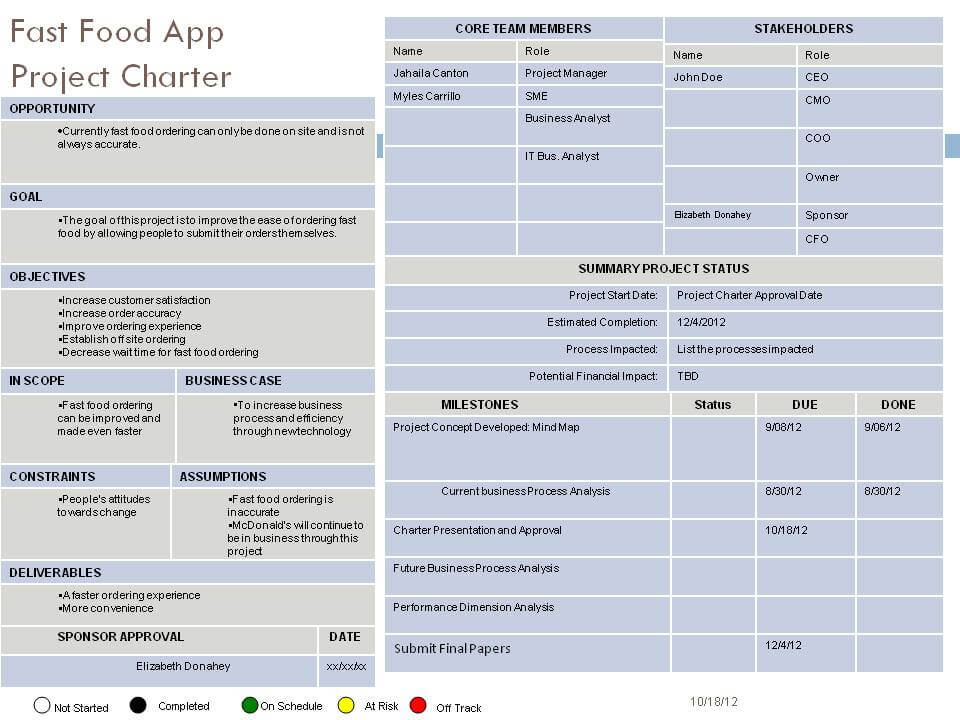Project charters outline the scope and objectives of your project. If you’re a project manager looking to kick off your new project on the right foot, a thoughtful, comprehensive charter is the way to start, and it saves you time down the line.
In this guide, I’ll describe what a project charter is and how a well-crafted one keeps us on track throughout the project management life cycle. You’ll also find project charter samples, a project charter template, and a list of software tools to help you develop and manage your charter.
What is a Project Charter?
A project charter is a formal document that outlines the shared understanding of a project’s scope, development, and project objectives, while also defining the roles and responsibilities of each party involved. It’s generally a fairly short document.
Project charters give the green light for a project to begin. Similar to the legal definition of the word “charter,” a charter in project management authorizes a project to exist and empowers the project manager to execute the work and spend the project budget. If the charter is approved, the project moves into the planning phase.
You might also see a project charter referred to as a brief or project initiation document (PID).
Here's a quick recap:
When Should I Create the Project Charter?
The project manager should create the project charter during the project initiation phase. Documenting the purpose of the project, what activities will be part of execution, and who is responsible for performing which activities is critical for aligning key stakeholders before the project kickoff.
Project Charter Template & Sample
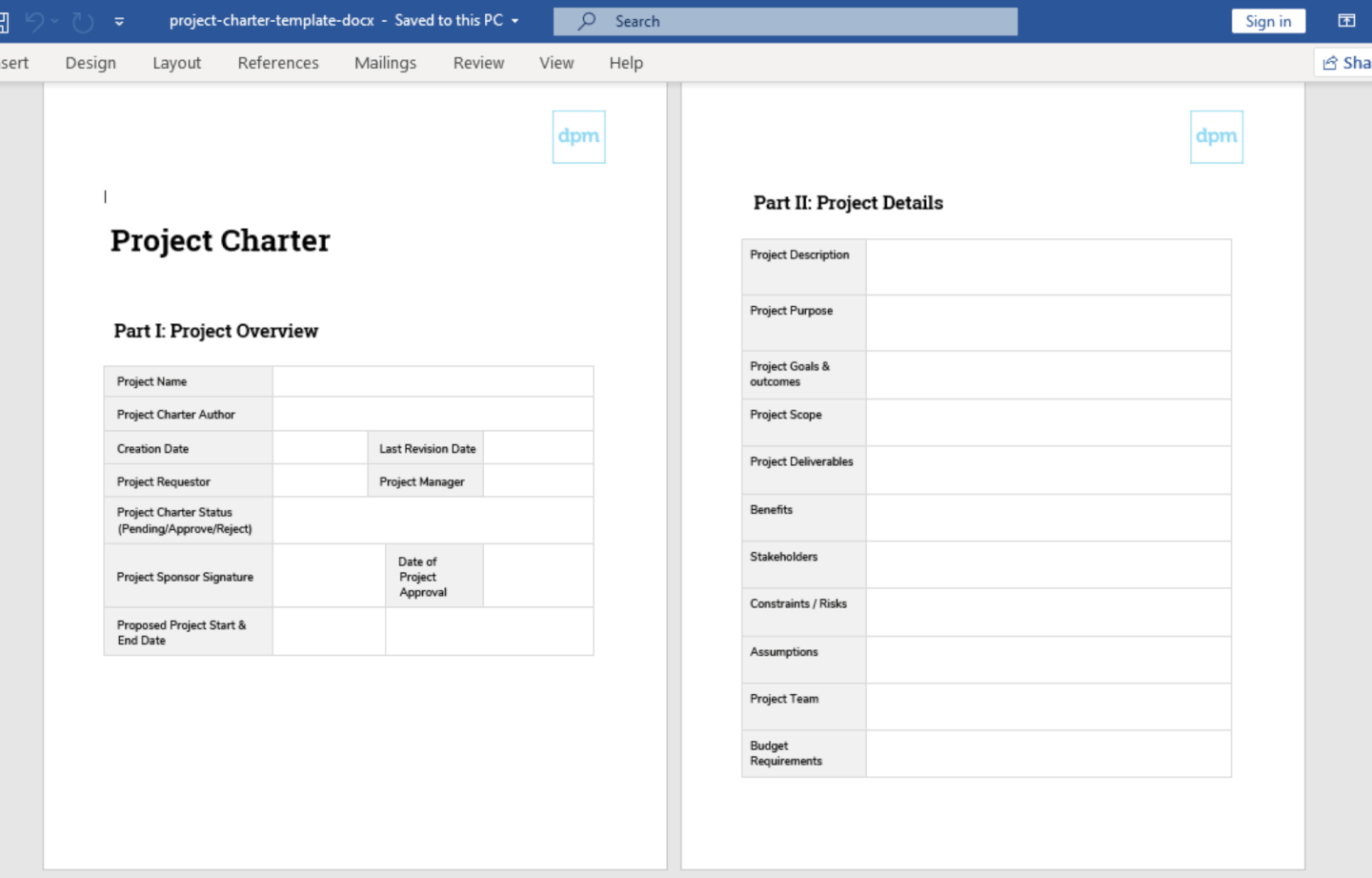
Download your template here and use this guide as you are completing it—the insights in this article will help you create a rock-solid project charter. We’ve also included a filled-in sample to give you an idea of what yours should look like.
Project Charter vs. Statement of Work and Project Plan
It’s easy to confuse a project charter with a SoW or a project management plan (also known as a project plan), as these documents are closely related. In this section, I’ll define each document and explain when and how you’d want to use it.
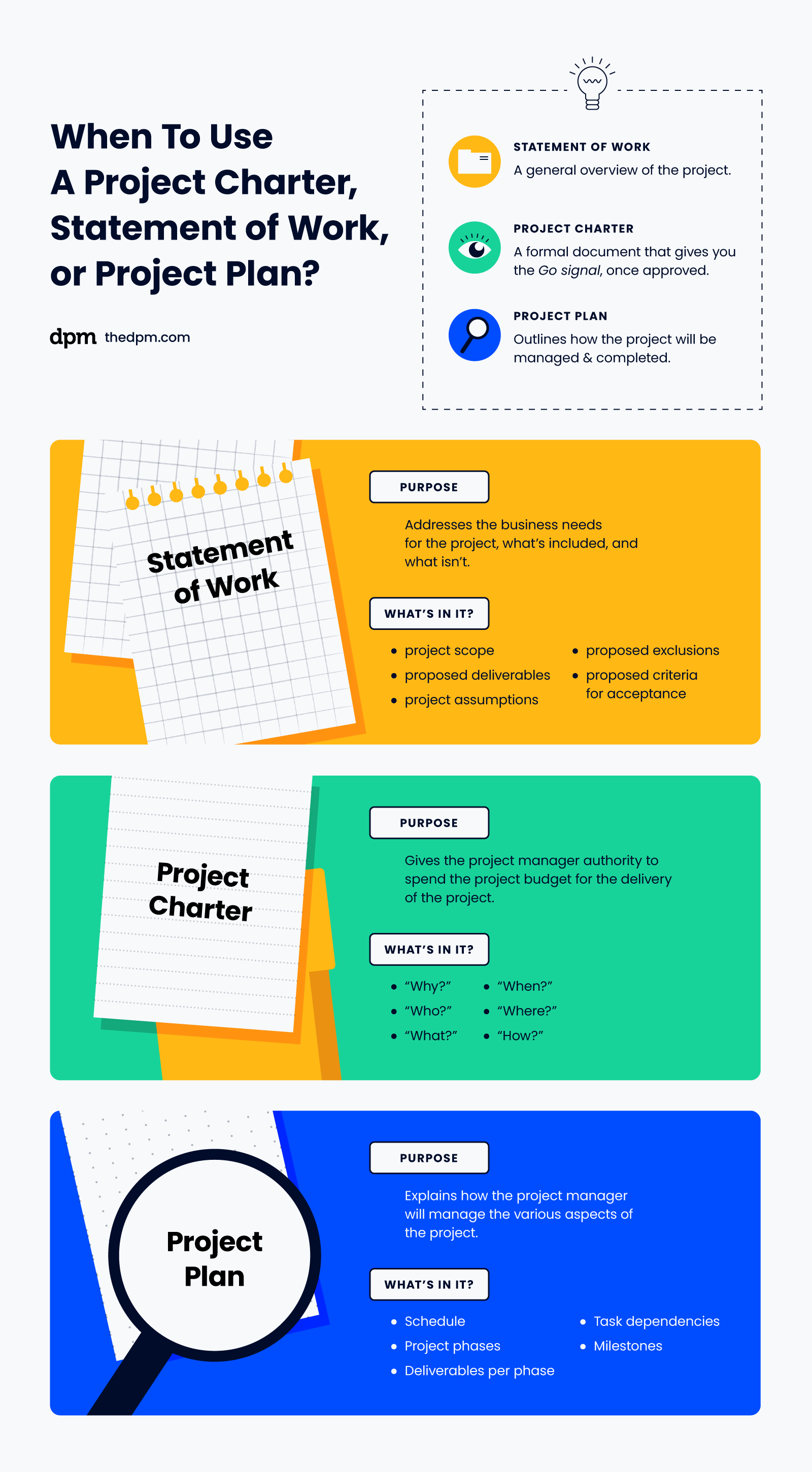
Statement Of Work
A SoW addresses the business need for a project, states what is included or not included as part of a project, and describes specific project deliverables. A SoW also typically summarizes project assumptions and proposed acceptance criteria.
A SoW is a crucial point of reference for project stakeholders, and it’s absolutely essential for PMs to know how to create a SoW. While a well-written SOW can save you a world of trouble, on the flip side, even a tiny mistake can have massive repercussions down the line. You can think of the SoW as a precursor to and key source of input for the formal project charter.
Project Plan
Whereas the project charter explains the “what” and “why” of a project, the project plan describes the “how.” Similar to how the project charter builds on the SoW, the project plan builds on the project charter.
A project plan explains how you will manage the various aspects of a project, including potential risks, the project schedule, communications, etc.
Why is the Project Charter Important?
The project charter document is important because it's purpose is to get your stakeholders to agree on why you’re doing the project, what’s in scope (at a high level), and who’s doing what. Some organizations require a signed project charter before allocating resources, including funding, to your project.
Let’s consider the benefits more in-depth, from the perspectives of each party involved.
Benefits for Project Managers & Teams
- Articulates project value proposition: helps you determine if it’s worthwhile to carry out the project
- Saves time down the road: the time you take to clarify objectives at the beginning of a project is time you won’t need to spend troubleshooting and negotiating later in the project life cycle
- Clarifies the budget: ensures that funding is available and will be released on time. Settling your spending authority and budgets saves time prior to starting the project.
- Sets clear guidelines for your project team: defining success criteria is invaluable for guiding the team as you begin to brief out the project
- Boosts team morale: a team working under a sloppy charter will repeatedly find themselves confused, with their hard work wasted or headed in the wrong direction. A well-written charter gives metrics for a successful project that your team can feel motivated and confident to work toward.
Benefits for Clients & Other Stakeholders
- Creates a shared understanding: stakeholders know what to expect and what constraints the project faces
- Serves as a marketing tool: the project charter can function as a sales document to justify new or existing investments.
What to Include in a Project Charter
Here's what to include in your project charter:
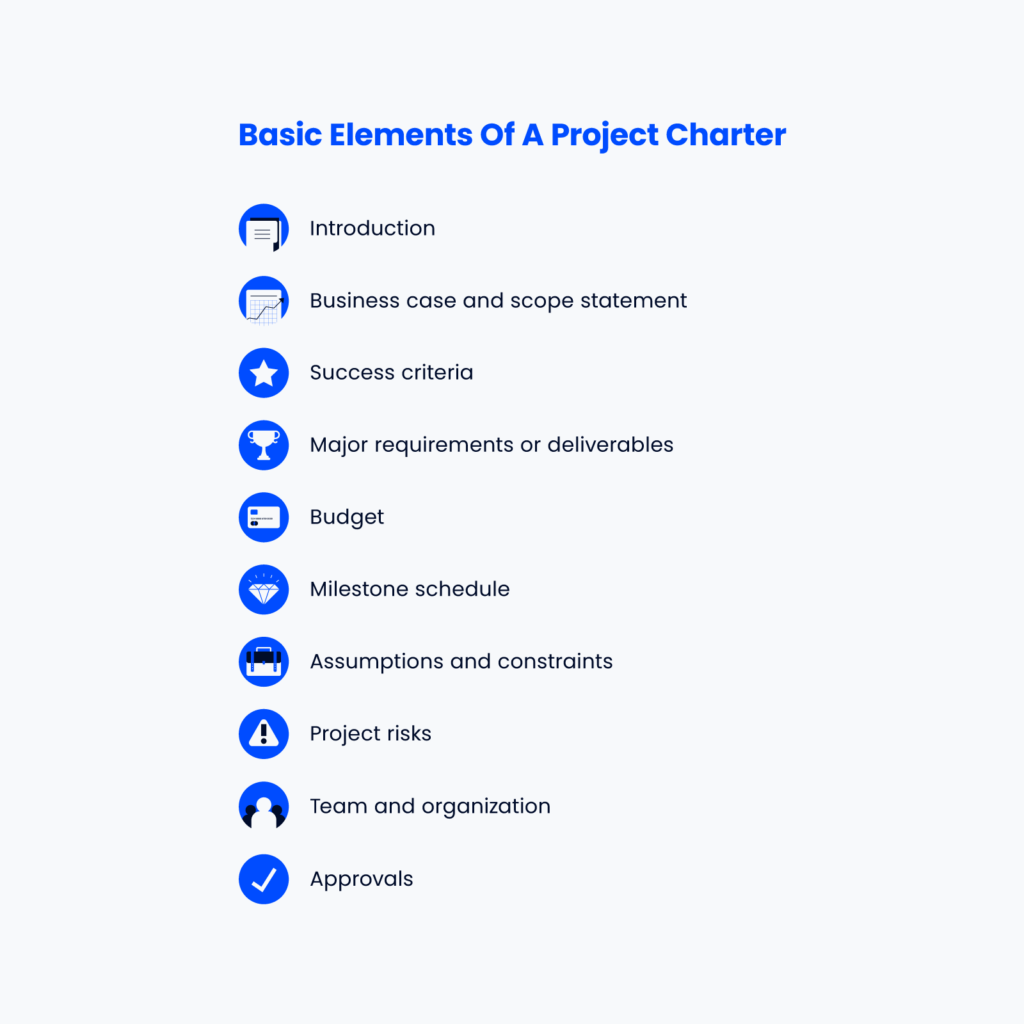
- Introduction: explains the purpose of the charter and provides the project name
- Business case and scope statement: explains the purpose of the project (including business drivers and any related projects), defines high-level activities that are part of the scope of the project (this will help avoid scope creep later), and covers the expected return on investment
- Success criteria: defines what success looks like and how the team will measure success
- Major requirements or deliverables: summarizes high-level requirements and/or key deliverables
- Budget: estimates project costs, ideally by project phase, and defines sources of project funding
- Milestone schedule: estimates project duration and summarizes each major part of the project and all milestones
- Assumptions and constraints: identifies known and unknown parameters upon project initiation
- Project risks: summarizes major known threats or opportunities that may affect project success
- Team and organization: defines project roles and responsibilities
- Approvals: includes a space for stakeholders to record their approval (or disapproval) of the charter.
In addition to these project charter sections, you may also include an appendix with documents such as:
- List of deliverables: if deliverables are already defined, this list contains details about each deliverable—what it is and the associated acceptance criteria
- Scheduling documents: project timeline, calendar, or other documents that sequence project activities and include details about each project milestone or phase
- Communication plan: this includes details about how each person involved will be kept informed about progress, changes, etc.
The Project Management Institute’s Guide to the Project Management Body of Knowledge (PMBOK) is a good reference for more information about each of these key elements.
How to Create a Project Charter
There’s no single right way to create a project management charter, but here is a basic process you could consider:
1. Discuss With Stakeholders & Team
Gather information about the project by meeting with key stakeholders, including the project manager, sponsors, clients, and representative project team members. Don’t forget that stakeholders may also include other teams that provide specialized support, such as network capacity and security experts.
2. Take & Organize Notes
In your discussions, ask questions and take notes that help you to fill out each of the sections of your charter. Use your time wisely to collect the most salient information; you can always fill in the supporting details later on.
3. Use A Template
Take advantage of the myriad project charter templates available online to create the format that best serves your project needs. DPM Members can use our pre-made charter template, along with a bunch of other time-saving resources. Alternatively, you could use one of the sample project charters in this post as a starting point.
Or, if you want to build your own charter from scratch, you can work through this detailed guide from the Treasury Board of Canada, line-by-line.
4. Include Specific Information
Let’s start with a bad example. For a banking client, a project manager writes the project goal statement in the charter as “improve communication channels.” Yes, good communication is a worthy goal, but the way this is written leaves a lot to the imagination:
- Whose communication channels will be improved? Customers? Internal staff?
- How many users’ needs are we trying to address?
- Will we be updating an existing system or building a completely new system?
- When will it be completed?
- Does the scope extend to training on the new communication tool?
- Will the contract include any ongoing support for the system?
A complete charter would provide clear, specific information on these questions so that the reader can understand the project purpose. Here’s a better example:
“Create a new communication system to replace ABC system by December 2024, so that customers can chat with their product managers via XYZ bank’s proprietary mobile apps. Train 400 employees to maintain and support the system in-house.”
Of course, this is only the goal statement, not the entire charter. Yet, this example showcases the difference between a sloppily written and a thoughtfully written charter. Apply similar logic to craft other sections of the charter. The goal of this exercise is for the project sponsor to have sufficient information to be able to approve the project.
5. Review With Team Representatives
After drafting a project charter but before reviewing it with a client, set aside time to review the charter with key members of your team to assess accuracy and completeness.
6. Present For Approval
Notice that this step is not “send for approval.” The project charter is the key to getting approval to undertake the project, and it’s important that it’s presented properly. Avoid simply attaching your charter as a PDF in an email, only to be ignored or dismissed out of hand.
Instead, present your charter to your sponsors, stakeholders, or clients—do this in a meeting or through a slide presentation that includes supporting media. Make sure you leave sufficient time for questions and answers.
Project Charter Examples
Here are three different examples of project charters to consider:
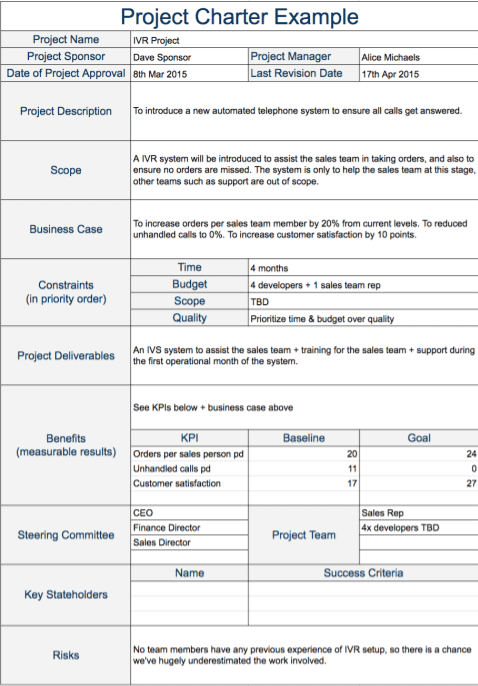
In this example project charter for an interactive voice response system, the project manager has included some notes on the business case, in addition to a project description and the scope. They've also listed the constraints in priority order, which is useful for providing quick context to whoever is reading this document.
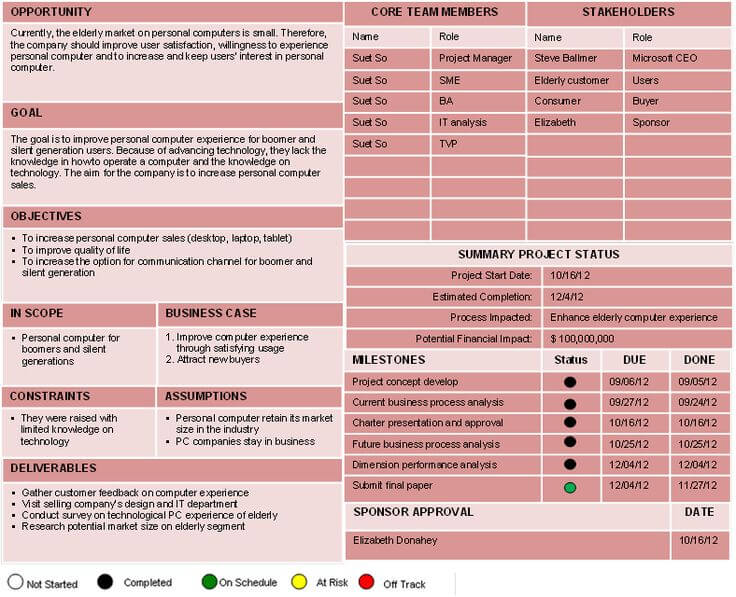
This project charter example clearly lists the project objectives, as well as the milestones and an accompanying timeline. While you don't necessarily need a complete timeline yet (this will be defined in the project plan), this is a good item to include and then update for project status reports, as the team is completing the work in the execution phase.
This one is similar to the above example in that it includes milestones and a timeline. It has also clearly laid out the objectives and what's in scope, and includes some notes on the processes that the project will impact, which is useful as this relates to the constraint of attitude towards change (which is listed in the constraints section).
Expert Tips for Creating a Project Charter
When creating a project charter, keep in mind these tips and best practices:
- Keep it simple. Your project charter should leave no room for interpretation. A layperson with no knowledge of the project or your organization should be able to pick up the document and understand what’s going on.
- Big picture over details. Provide a high level overview of the project purpose and outcomes, and avoid getting bogged down in unnecessary details that hinder alignment or create accountability problems later on.
- Create consensus. You could draft the most eloquent project charter on the planet, but it serves no purpose if stakeholders aren’t willing to agree to it. Remember that the project charter is a tool that supports stakeholder alignment. If your charter doesn’t bring stakeholders together, there’s no point in writing one.
Project Management Tools For Developing & Managing Charters
Software tools offer a simple way to develop and store your project charter in an accessible place where all stakeholders and team members can access it as needed.
Types of project management software tools that can be useful include:
- Project management software: You can enter the details about objectives and scope from your project charter and then measure how you're tracking against them throughout the project.
- Mind mapping software: This software is useful for brainstorming and organizing information about the project before you start creating a charter.
- Gantt chart maker: Use this software for plotting milestones and timelines, which will come in handy after your charter is approved.
What's Next?
Have more questions about RACI charts? Become a DPM member and join the conversation in Slack with 100s of other digital project managers! You’ll also get access to 100+ templates, samples, and examples of project documents, which will save you time and increase your chances of project success.




